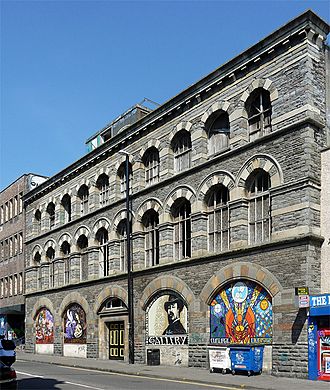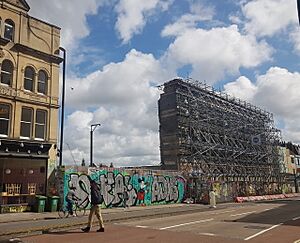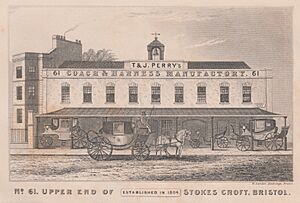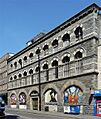Carriage Works, Bristol facts for kids
Quick facts for kids Carriage Works |
|
|---|---|

The Carriage Works in 2012
|
|
| General information | |
| Town or city | Bristol |
| Country | England |
| Coordinates | 51°27′50″N 2°35′22″W / 51.4640°N 2.5894°W |
| Completed | 1862 |
| Design and construction | |
| Architect | Edward William Godwin |
The Carriage Works (grid reference ST591740) was an important building in Stokes Croft, Bristol, England. It was first built to make and sell carriages. Over the years, it was used for many different things.
Contents
Building History
The Carriage Works was built in 1862. A famous architect named Edward William Godwin designed it. It was made from strong Pennant stone with Bath stone details.
Before this building, there was an older factory on the same spot. It was called T&J. Perry's Coach & Harness Manufactory. It had been making carriages since 1804. The new Carriage Works building took its place.
Design and Early Use
The building had a special look. It featured round arches and other curved shapes. The ground floor arches were open. This allowed carriages from John Perry and Sons to easily enter and leave. In 1844, Thomas and John Perry paid £3 a year to rent this important site.
Changes Over Time
As time went on, the world changed. By the early 1900s, Perry's started making cars instead of just horse carriages. This shows how they kept up with new technology.
Later, from 1913 to the 1960s, the building had a new purpose. It was used by Anderson's Bristol Rubber Co. Ltd. to process rubber.
In the 1960s, the building became home to Regional Pools Promotions. This was a group that ran a membership scheme. It gave out prizes and raised money for charity. Later, this group moved to the building next door, called Westmoreland House.
Protecting the Building
The Carriage Works is a very special building. English Heritage has given it a grade II* listed building status. This means it is a very important historical building. It is an example of the Bristol Byzantine style of architecture.
However, the building has been in poor condition. It was even on the English Heritage Heritage at Risk Register. This list includes important buildings that need urgent care.
Future Plans
In September 2011, a group called the Carriageworks Action Group started. This group wanted to get ideas from the community. They aimed to decide what to do with the building and the land around it. Local people, groups, and businesses joined the Action Group. Bristol City Council also supported them. They worked to create a "community vision" for the site.
In June 2013, a housing association called Knightstone Housing was chosen. They were picked to develop the site. In 2015, a plan was submitted to Bristol City Council. It was from a company called Fifth Capital. The plan was to build 112 homes and other mixed-use spaces. Assael Architecture designed this plan.
The plan was approved in October 2015. Some people were worried because the plan did not include enough affordable housing.
Demolition and Preservation
On November 21, 2018, most of The Carriage Works was taken down. The building next to it, Westmoreland House, was also demolished. However, the front part, or facade, of The Carriage Works was saved. It remains standing today.
Images for kids






